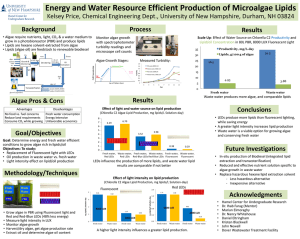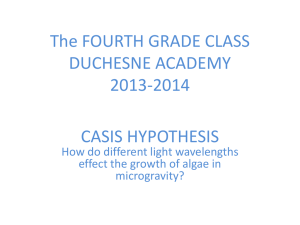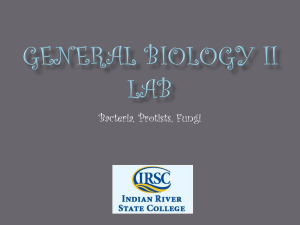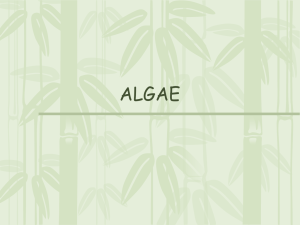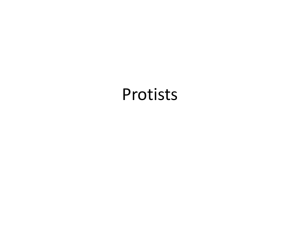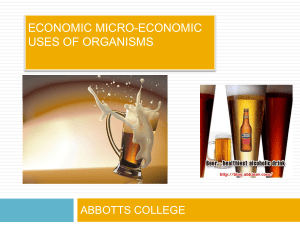Analysis of Algae Lipids by HPLC and Mass Spectroscopy
advertisement
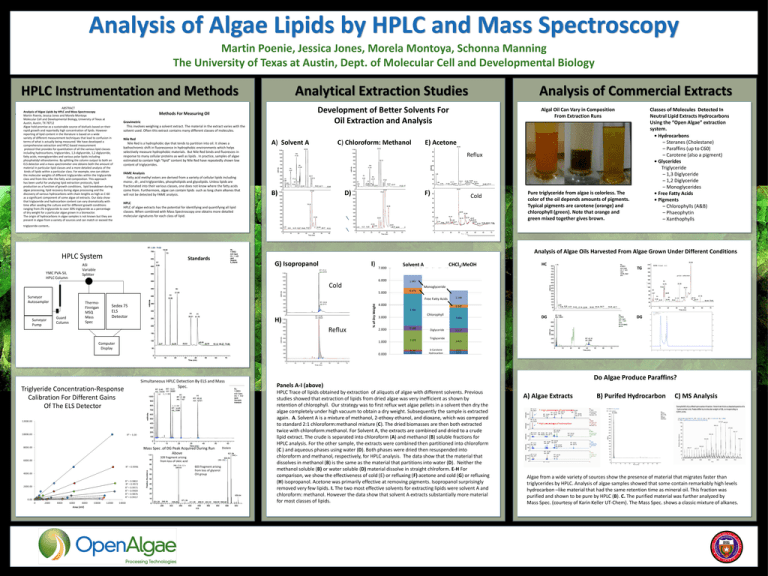
Analysis of Algae Lipids by HPLC and Mass Spectroscopy Martin Poenie, Jessica Jones, Morela Montoya, Schonna Manning The University of Texas at Austin, Dept. of Molecular Cell and Developmental Biology HPLC Instrumentation and Methods • Bulleted Points ABSTRACT Analysis of Algae Lipids by HPLC and Mass Spectroscopy Martin Poenie, Jessica Jones and Morela Montoya Molecular Cell and Developmental Biology, University of Texas at Austin, Austin, TX 78712 Algae hold promise as a sustainable source of biofuels based on their rapid growth and reportedly high concentration of lipids. However reporting of lipid content in the literature is based on a wide variety of different measurement techniques that lead to confusion in terms of what is actually being measured. We have developed a comprehensive extraction and HPLC-based measurement protocol that provides for quantitation of all the various lipid classes including hydrocarbons, triglycerides, 1,3-diglyceride, 1,2 diglyceride, fatty acids, monoglycerides and various polar lipids including phosphatidyl ethanolamine. By splitting the column output to both an ELS detector and a mass spectrometer one obtains both the amount of material in particular lipid classes and a more detailed analysis of the kinds of lipids within a particular class. For example, one can obtain the molecular weights of different triglycerides within the triglyceride class and from this infer the fatty acid composition. This approach has been useful for analyzing lipid extraction protocols, lipid production as a function of growth conditions, lipid breakdown during algae processing, lipid recovery during algae processing and the discovery of various hydrocarbons with chain lengths as high as C-60 as a significant component of some algae oil extracts. Our data show that triglyceride and hydrocarbon content can vary dramatically with time after seeding the culture and for different growth conditions ranging from 2% triglyceride to over 30% triglyceride as a percentage of dry weight for a particular algae grown in a bioreactor. The origin of hydrocarbons in algae samples is not known but they are present in algae from a variety of sources and can match or exceed the – Subtext Analytical Extraction Studies Development of Better Solvents For Oil Extraction and Analysis Methods For Measuring Oil Gravimetric This involves weighing a solvent extract. The material in the extract varies with the solvent used. Often this extract contains many different classes of molecules. Nile Red Nile Red is a hydrophobic dye that tends to partition into oil. It shows a bathochromic shift in fluorescence in hydrophobic environments which helps selectively measure hydrophobic materials. But Nile Red binds and fluoresces in response to many cellular proteins as well as lipids . In practice, samples of algae estimated to contain high “lipid” content by Nile Red have repeatedly shown low content of triglycerides. FAME Analysis Fatty acid methyl esters are derived from a variety of cellular lipids including mono-, di-, and triglycerides, phospholipids and glycolipids. Unless lipids are fractionated into their various classes, one does not know where the fatty acids come from. Furthermore, algae can contain lipids such as long chain alkanes that will not be detected by FAME analysis. Analysis of Commercial Extracts A) Solvent A C) Chloroform: Methanol Algal Oil Can Vary in Composition From Extraction Runs Classes of Molecules Detected In Neutral Lipid Extracts Hydrocarbons Using the “Open Algae” extraction system. • Hydrocarbons – Steranes (Cholestane) – Paraffins (up to C60) – Carotene (also a pigment) • Glycerides Triglyceride – 1,3 Diglyceride – 1,2 Diglyceride – Monoglycerides • Free Fatty Acids • Pigments – Chlorophylls (A&B) – Phaeophytin – Xanthophylls E) Acetone Reflux B) D) F) Cold HPLC HPLC of algae extracts has the potential for identifying and quantifying all lipid classes. When combined with Mass Spectroscopy one obtains more detailed molecular signatures for each class of lipid. Pure triglyceride from algae is colorless. The color of the oil depends amounts of pigments. Typical pigments are carotene (orange) and chlorophyll (green). Note that orange and green mixed together gives brown. . triglyceride content Analysis of Algae Oils Harvested From Algae Grown Under Different Conditions Separation of Lipid Standards Standards G) Isopropanol I) 7.000 6.000 Cold Solvent A HC KT TG DG ChL FFA MG 0.474 % of Dry Weight 4.000 Triglyeride Concentration-Response Calibration For Different Gains Of The ELS Detector Mass Spec .of DG Peak Acquired During Run Above 339 fragment arising from loss of oleic acid 603 fragment arising from loss of glycerol OH group Diolein 1.148 0.246 2.601 Chlorophyll 3.000 1.656 2.000 0.388 1.000 1.578 0.000 Simultaneous HPLC Detection By ELS and Mass Spec. TG 1.047 Free Fatty Acids Reflux HC Monoglyceride 5.000 H) CHCl3:MeOH 0.113 0.236 Diglyceride Triglyceride b-Carotene Hydrocarbon DG DG 0.357 1.425 0.072 0.270 Do Algae Produce Paraffins? Panels A-I (above) HPLC Trace of lipids obtained by extraction of aliquots of algae with different solvents. Previous studies showed that extraction of lipids from dried algae was very inefficient as shown by retention of chlorophyll. Our strategy was to first reflux wet algae pellets in a solvent then dry the algae completely under high vacuum to obtain a dry weight. Subsequently the sample is extracted again. A. Solvent A is a mixture of methanol, 2-ethoxy ethanol, and dioxane, which was compared to standard 2:1 chloroform:methanol mixture (C). The dried biomasses are then both extracted twice with chloroform:methanol. For Solvent A, the extracts are combined and dried to a crude lipid extract. The crude is separated into chloroform (A) and methanol (B) soluble fractions for HPLC analysis. For the other sample, the extracts were combined then partitioned into chloroform (C ) and aqueous phases using water (D). Both phases were dried then resuspended into chloroform and methanol, respectively, for HPLC analysis. The data show that the material that dissolves in methanol (B) is the same as the material that partitions into water (D). Neither the methanol soluble (B) or water soluble (D) material dissolve in straight chlroform. E-H For comparison, we show the effectiveness of cold (E) or refluxing (F) acetone and cold (G) or refluxing (H) isopropanol. Acetone was primarily effective at removing pigments. Isopropanol surprisingly removed very few lipids. I. The two most effective solvents for extracting lipids were solvent A and chloroform: methanol. However the data show that solvent A extracts substantially more material for most classes of lipids. A) Algae Extracts B) Purifed Hydrocarbon C) MS Analysis Algae from a wide variety of sources show the presence of material that migrates faster than triglycerides by HPLC. Analysis of algae samples showed that some contain remarkably high levels hydrocarbon –like material that had the same retention time as mineral oil. This fraction was purified and shown to be pure by HPLC (B). C. The purified material was further analyzed by Mass Spec. (courtesy of Karin Keller UT-Chem). The Mass Spec. shows a classic mixture of alkanes.

